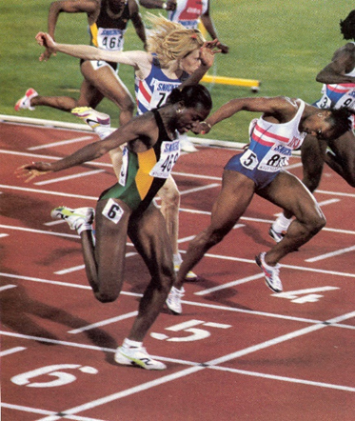I have decided to write a small series about performance enhancement in elite sports. Enhancing performance is not an easy task in elite sports for several reasons.
In many sports an athlete has to train really hard to be able to make a difference, this due to the extreme evolution in many sports. Performance improvement is easy in the beginning but becomes harder and harder as the athlete develops and the level increases. In the beginning one improves by meters and seconds, after a few years one struggles for every centimeter and millisecond.
An example:
When you find a young guy running 11.00 seconds at the age of 17, then you are lucky to see him run 10.00 seconds 10 years later; so we are looking at a 10% improvement in 10 years’ time, which gives us an average of only 1% improvement per year, and then you have to be lucky (from 1).
In the environment of world class athletes, small margins make a large difference. A good example of a marginal difference is the World Championship Indoors Indianapolis 1987 where in the 60 meter final for women, Nelli Cooman ran 7.08, beating Canadian favorite Angela Issayenko, coached by Charlie Francis, by 0.003 secs, (1).

Another example where I was involved, is the race between Gail Devers (USA) and Merlene Ottey (Jamaica) during the 100 meter finals at the World Championship in Stuttgart in 1993. Gail ran 10.811 seconds and Merlene 10.812 seconds, (1).

Early in my career I realized that in order to be successful as a coach, one has to look at a wide spectrum of performance-variables or factors that in the end can make a difference somewhere down the line. As you can see from the examples above, small improvements can make the difference between winning and losing, success or failure, becoming a world champion or just having been there.
In more recent times this principle has been popularized by Dave Brailsford, director of British cycling, and seen as the engine behind the successes of British cycling. He stated: “The whole principle came from the idea that if you break down everything you could think of that goes into riding a bike, and then improve it by 1 percent, you will get a significant increase when you put them all together”.
Often, success is produced by small factors, often repeated, i.e. every day or every work-out, so the effects will accumulate over time. And leaving out limiting factors, small or almost insignificant looking factors, like bad habits, every day.
Here are three main factors that are decisive for an athlete’s career:
For the coach:
- choose the right athlete,
For the athlete:
- Choose the right parents
- Choose the right coach
Assuming you and your athlete have made these right choices, we can start looking at what needs to be done. As a coach, our main task is to optimize the training process, which is a useless phrase if you don’t know what it means and how to do that. Methodology of training should be the primary concern of every coach.
All other things are of secondary importance. The coach is normally not a specialist, like a psychologist, a bio mechanist, or a nutritionist. Still, many coaches tend to limit their concept by focusing on one of these fields. They spend a lot of time explaining biomechanics or technique, but neglect nutrition or leave it out of the performance equation. So, what is important? That mainly depends on the sport, the athlete, his/her level and the knowledge level and interest (in other words, the education) of the coach.
In this series I will write about factors that might be important for enhancing the performance of your athletes, beyond regular training. Some factors you might know or you might have explored one of the topics already, some of them you might not. Some of these methods or tools are based on sound science, others are still experimental or fringe methods, not (yet) confirmed by large scale experiments or seen as redundant or neglected by mainstream science or training methodology. (2) It’s a mixed batch, you’ll see.
- Sleep and sleep enhancement.
- Grounding/earthing
- DNA testing
- Nutritional testing
- Aromatherapy
- Acupuncture-related interventions
- The effect of colors
- Local and whole body vibration
- Electromagnetic evaluation and interventions
- Exotic supplements
- Structural design of the athlete’s body
- Good habits
- Supportive measured, activities and tools.
Literature:
1 Kraaijenhof, H: What we need is speed; UAC, 2016
2 Smolianov, P; Smith,J: Fringe Methodologies in High Performance and Health; UAC, 2019
